 | ||
Chameria against greek propaganda
Chameria (Albanian: Çamëria, Greek: Τσαμουριά Tsamouriá, Turkish: Çamlık) is a term used today mostly by Albanians for parts of the coastal region of Epirus in southern Albania and northwestern Greece traditionally associated with an Albanian speaking population called Chams. Apart from geographical usages, in contemporary times within Albania the toponym has also acquired irredentist connotations. During the interwar period, the toponym was in common use and the official name of the area above the Acheron river in all Greek state documents. Today it is obsolete in Greek, surviving in some old folk songs. Most of what is called Chameria is divided between the Greek regional units of Thesprotia and Preveza, the southern extremity of Albania's Sarandë District and some villages in eastern Ioannina regional unit. As the Greek toponyms Epirus and Thesprotia have been established for the region since antiquity, and given the negative sentiments towards Albanian irredentism, the term is not used by the locals on the Greek side of the border.
Contents
- Chameria against greek propaganda
- Etymology
- Geography and boundaries
- Mycenean period
- Iron Age to Roman period
- Middle Ages
- Ottoman rule
- Modern history
- Demographics
- Historical
- Current
- Muslims
- Christian Orthodox
- References
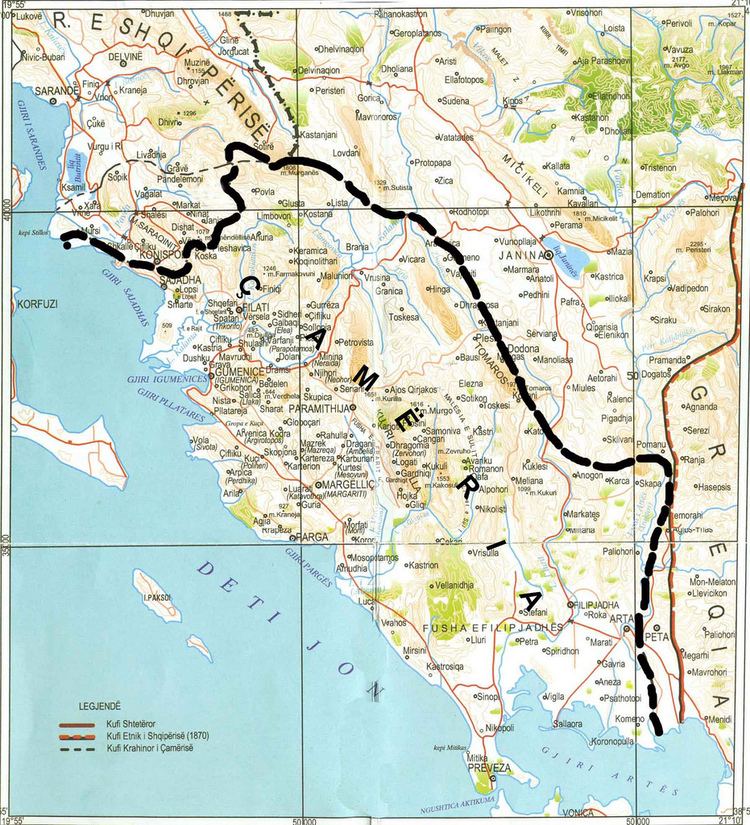
Etymology

Chameria was mostly used as a term for the region of modern Thesprotia, during the Ottoman rule. It is of uncertain etymology. It possibly derives from the ancient Greek name of the Thyamis river, which in the Albanian language is called Cham (Çam), through the unattested Slavic *čamь or *čama rendering the older Slavic *tjama.
Geography and boundaries
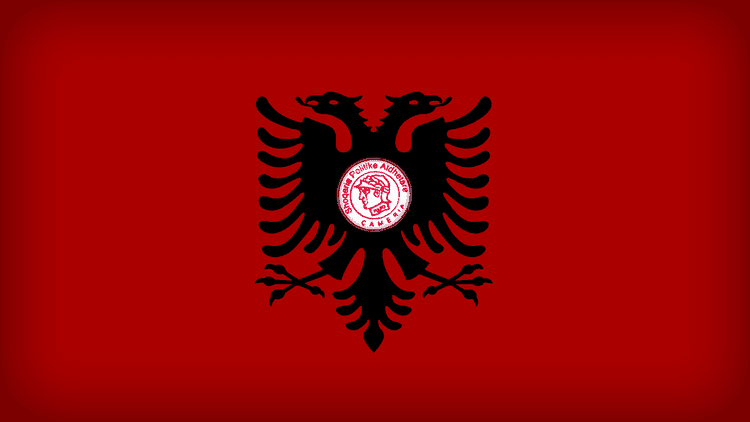
The region of Chameria overlaps to a high degree with the ancient and modern region of Thesprotia and the medieval region known as Vagenetia, lying north of Ambracian Gulf and west of the Pindus mountains. The northern boundary of the region is not precisely defined: in Antiquity, the northern boundary of Thesprotia was the Thyamis river, but in the Middle Ages, the presumed borders were pushed to the north. Vagenetia included today's Sarandë District and Delvinë District of Southern Albania, bordering with the Llogara and Muzina mountains in the north and northeast.
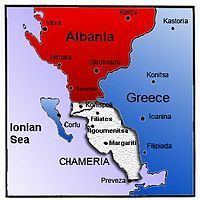
In modern times, the region of Chameria was reduced to the dialectological territory of the Chams, stretching between the mouth of the Acheron river in the south, the area of Butrint in the north, and the Pindus in the east. After the permanent demarcation of the Greco-Albanian border, only two small municipalities were left in southern Albania (Markat and Konispol), while the remainder was part of the Epirus periphery of Greece.
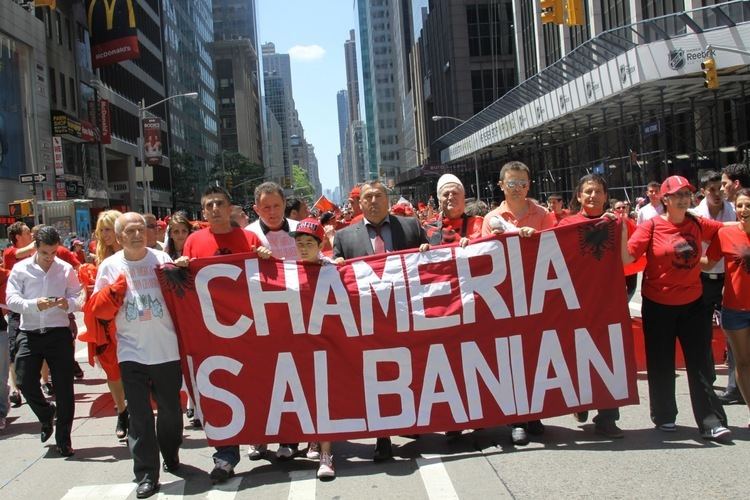
The early 19th c. Greek author Perraivos, notable for his works on Souli and Epirus, notes that the Albanian Chams inhabit the area between the Bistrica river in the north and the Souli area south. In the early 1800s British colonel William Martin Leake while in the area described Chameria as stretching from the boundaries of Butrint and Delvinë until the Fanari and Paramythia areas consisting of two main sub-districts, Daghawi or Dai and Parakalamos. During the 19th century, the novelista and poet Nikolaos Konemenos, an Arvanite from the area placed his home district of Lakka (Λάκκας) within the bounds of Tsamouria (Τσαμουριά) or Chameria. In the early 1880s, British diplomat Valentine Chirol who spent time in the area during the Eastern Crisis defined Chameria along linguistic lines in geographic terms where Albanian speakers were found during that time. Chirol states that the Thiamis river basin, the Souli mountains, the Louros river valley up until the Preveza peninsula formed part of the district called "Tchamouria" which referred to the "southernmost Albanian settlements in Epirus". Chirol also noted that due to the spread of the Chams in the area, the toponym also applied to the centre of the region where they held "undivided sway". Sami Frashëri, a noted Ottoman intellectual of Albanian origin who compiled the first Ottoman dictionary Kamus al-a’lam (Universal Dictionary of History and Geography) wrote in various article entries pertaining to the region that Chameria consisted of the towns of Paramythia, Filiates and Preveza. While the Ottoman administrative units or kazas of Paramythia, Filiates and Preveza formed the area of Chameria.
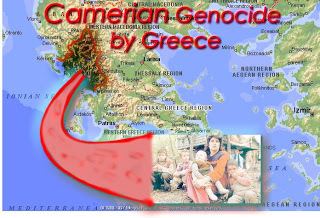
During the interwar period of the twentieth century British historian Nicholas Hammond traversed the region and described Chameria as consisting of main settlements like Paramythia and Margariti. He also described the Chameria region as pertaining to the Thiamis river basin, covering the Margariti district and heading all the way down to coastal villages like Loutsa of the Acheron plain in the south which contained Albanian speaking settlements. Pre-War Greek sources say that the coast of Chameria extended from the Acheron River to Butrint and the inland reaches east till the slopes of Mount Olytsikas (or Tomaros). The center of Chameria was considered to be Paramythia and other areas were Filiates, Parga and Margariti. In various Greek sources of the interwar era they also at times include the Greek speaking area to the east of Filiates within Chameria, while excluding the Albanian speaking area of Fanari known also as Prevezaniko. Throughout the interwar period, Chameria in official Greek government documents related to the area north of the Acheron river. Current day scholarship gives diverging descriptions of Chameria. Within Greek scholarship the following definitions are given. Lambros Baltsiotis states that it includes a small part of Albanian territory, consisted of the western part of Thesprotia prefecture and north of Preveza regional unit (former Preveza prefecture), stretching down to Fanari. Leonidas Kallivretakis states that the Greek part of the Chameria region is limited to Thesprotia prefecture. Similarly, Eleftheria Manta and Kyriakos Kentriotis state that the southern limits of the region are found in the mouth of Acheron river. While Robert Elsie states that Chameria corresponds to Thesprotia and Preveza prefectures and including a small area around Konispol town in Albania. Elsie describes Chameria as containing the river basins of the Thiamis and Acheron rivers and Ionian coastline all the way down to Preveza while excluding Corfu island, the Epirote interior and the city of Ioannina.
Mycenean period
Late Mycenean sites have been found in the following areas of Chameria:
Iron Age to Roman period
There are numerous archeological sites from Iron Age (10th to 7th centuries) onwards. In Thesprotia, which can be considered the centre of Chameria, excavations have brought to light finds of this period in the Kokytos valley. The Nekromanteion of Acheron is probably the most important site of the area in antiquity, mentioned already in Homer. Archaeological findinds indicate that a sancturary existed there by 7th century BC. It seems that it ceased to function as an oracle in Roman period. Other important settlements are Ephyra, Buthrotum, the Cheimerion (5 km west of Ephyra), Photike (some identify it with Paramythia), the port of Sybota, the city of Thesprotia, the port city of Elea (in the region of Thesprotia) which is believed to be a Corinthian colony, Pandosia, a colony of Elis, Tarone, near the mouth of river Thyamis, and others, depending on the definition of Chameria.
Middle Ages
In Medieval Ages the region was under the jurisdiction of the Roman and later Byzantine Empire. In 1205, Michael Komnenos Doukas, a cousin of the Byzantine emperors Isaac II Angelos and Alexios III Angelos, founded the Despotate of Epiros, which ruled the region until the 15th century. Vagenetia as the whole of Epirus soon became the new home of many Greek refugees from Constantinople, Thessaly, and the Peloponnese, and Michael was described as a second Noah, rescuing men from the Latin flood. During this time, the earliest mention of Albanians within the region of Epirus is recorded in a Venetian document of 1210 as inhabiting the area opposite the island of Corfu. The first appearance of Albanians in sizable numbers within the Despotate of Epirus is not recorded before 1337 in which Byzantine sources present them as nomads.
In the 1340s, taking advantage of a Byzantine civil war, the Serbian King Stefan Uroš IV Dušan conquered Epirus and incorporated it in his Serbian Empire. During this time, two Albanian states were formed in the region. In the summer of 1358, Nikephoros II Orsini, the last despot of Epirus of the Orsini dynasty, was defeated in battle against Albanian chieftains. Following the approval of the Serbian Tsar, these chieftains established two new states in the region, the Despotate of Arta and Principality of Gjirokastër. Internal dissension and successive conflicts with their neighbours, including the rising power of the Ottoman Turks, led to the downfall of these Albanian principalities to the Tocco family. The Tocco in turn gradually gave way to the Ottomans, who took Ioannina in 1430, Arta in 1449, Angelokastron in 1460, and finally Vonitsa in 1479.
Ottoman rule
During the Ottoman rule, the region was under the Vilayet of Ioannina, and later under the Pashalik of Yanina. During this time, the region was known as Chameria (also spelled Tsamouria, Tzamouria) and became a district in the Vilayet of Yanina. The wars of the eighteenth and early nineteenth centuries between Russia and the Ottoman Empire negatively impacted upon the region. Increased conversions to Islam followed, often forced, such as those of 25 villages in 1739 which are located in current day Thesprotia prefecture.
In the 18th century, as the power of the Ottomans declined, the region came under the semi-independent state of Ali Pasha Tepelena, an Albanian brigand who became the provincial governor of Ioannina in 1788. Ali Pasha started campaigns to subjugate the confederation of the Souli settlements in this region. His forces met fierce resistance by the Souliotes warriors. After numerous failed attempts to defeat the Souliotes, his troops succeeded in conquering the area in 1803.
After the fall of the Pashalik, the region remained under the control of the Ottoman Empire, while Greece and Albania declared that their goal was to include in their states the whole region of Epirus, including Thesprotia or Chameria. With the rise of the Albanian national movement in the late 19th century, the local Orthodox Albanian speaking population did not share the national ideas of their Muslim Albanian speaking neighbours. Instead they remained Greek-oriented and identified themselves as Greeks. Finally, following the Balkan Wars, Epirus was divided in 1913, in the London Peace Conference, and the region came under the control of Kingdom of Greece, with only a small portion being integrated into the newly formed State of Albania.
During the Ottoman era, Chameria had a feudal system of administration. The most important and older feudal clan was that of Pronjo of Paramythia (Drandakis).
Modern history
When the region came under Greek control in 1913, its population included speakers of Greek, Albanian, Aromanian and Romani.
Muslim Chams were counted as a religious minority, and some of them were transferred to Turkey, during the 1923 population exchange between Greece and Turkey, while their property was alienated by the Greek government as part of the relevant agreement between Greece and Turkey. Orthodox Cham Albanians were counted as Greeks, and their language and Albanian heritage were under pressure of assimilation. The region was then temporarily settled by Greek refugees from Asia Minor which most of whom were later moved to other areas in the country after Greece decided not to send Muslim Albanian Chams to Turkey.
In 1930s the population was approximately 70,000, the Muslim Albanian speakers estimated around 18,000–20,000. All the population, independently of religion of ethnicity, were called Chams (According to the 1928 census the total Muslim population in Greece was 126.017).
During the interwar period, the toponym Chameria was in common use within the region and the official name for the area above the Acheron river used in all government documents by the Greek state. In 1936, the Greek state created a new prefecture called Thesprotia, from parts of Ioannina and Preveza prefectures, as to exercise better control over the Muslim Albanian Cham minority. Cham Albanians were given religious, but no ethnic minority status and there was little evidence of direct state persecution at this time.
During the Axis occupation of Greece (1941–1944), most parts of the Muslim Cham community collaborated with the Italian and German forces committing a number of war crimes. At the end of World War II, nearly all Muslim Chams in Greece were expelled to Albania, because of that activity. However, a small part of Muslim Chams provided military support to the resistance forces of the Greek People's Liberation Army. Led by Zervas' former officer, Col. Zotos, a loose paramilitary grouping of former guerrillas and local men went on a rampage. In the town of Filiates on 13 March, some sixty to seventy axis Chams were killed.
Demographics
Since the Medieval Ages, the population of the region of Chameria was of mixed and complex ethnicity, with a blurring of group identities such as Albanian and Greek, along with many other ethnic groups. Information on the ethnic composition of the region over several centuries is almost entirely absent, with the strong likelihood that they did not fit into standard "national" patterns, as the 19th-century revolutionary nationalist movements wanted.
Historical
In early 19th century, Greek scholar and secretary of the local Ottoman ruler Ali Pasha, Athanasios Psalidas, stated that Chameria was inhabited by both Greeks and Albanians. The later were divided between Christians and Muslims, while Greeks were the dominant element of Chameria. In Greek censuses, only Muslims of the region were counted as Albanians. According to the 1913 Greek census, 25,000 Muslims were living at the time in the Chameria region who had Albanian as their mother tongue, from a total population of about 60,000, while in 1923 there were 20,319 Muslim Chams. In the Greek census of 1928, there were 17,008 Muslims who had it as their mother tongue. During the interwar period, the numbers of Albanian speakers in official Greek censuses varied and fluctuated, due to political motives and manipulation.
The main census that counted Orthodox communities of Albanian ethnicity was undertaken by Italian occupational forces and conducted during World War II (1941). This census found that in the region lived 54,000 Albanians, of whom 26,000 Orthodox and 28,000 Muslim and 20,000 Greeks. After the war, according to Greek censuses where ethno-linguistic groups were counted, Muslim Chams were 113 in 1947 and 127 in 1951. In the same Greek census of 1951, 7,357 Orthodox Albanian-speakers were counted within the whole of Epirus.
Current
With the exception of the part of Chameria lying in Albania, Chameria is nowadays inhabited mostly by Greeks as a result of the Cham exodus following World War II and subsequent assimilation of remaining Chams. The number of ethnic Albanians still residing in the Chameria region is uncertain, since the Greek government does not include ethnic and linguistic categories in any official census.
Muslims
The Greek census of 1951 counted a total of 127 Muslim Albanian Chams in Epirus. In more recent years (1986) 44 members of this community are found in Thesprotia, located in the settlements of Sybota, Kodra and Polyneri (previously Koutsi). Moreover, until recently the Muslim community in Polyneri was the only one in Epirus to have an imam. The village mosque was the last within the area before being blown up by a local Christian in 1972. The number of Muslim Chams remaining in the area after World War II included also people who converted to Orthodoxy and were assimilated into the local population in order to preserve their properties and themselves.
Christian Orthodox
According to a study by the Euromosaic project of the European Union, Albanian speaking communities live along the border with Albania in Thesprotia prefecture, the northern part of the Preveza prefecture in the region called Thesprotiko, and a few villages in Ioannina regional unit. The Arvanite dialect is still spoken by a minority of inhabitants in Igoumenitsa. In northern Preveza prefecture, those communities also include the region of Fanari, in villages such as Ammoudia and Agia. In 1978, some of the older inhabitants in these communities were Albanian monolinguals. The language is spoken by young people too, because when the local working-age population migrate seeking a job in Athens, or abroad, the children are left with their grandparents, thus creating a continuity of speakers.
Today, these Orthodox Albanian speaking communities refer to themselves as Arvanites in the Greek language and self-identify as Greeks, like the Arvanite communities in southern Greece. They refer to their language in Greek as Arvanitika and when conversing in Albanian as Shqip. In contrast with the Arvanites, some have retained a distinct linguistic and ethnic identity, but also an Albanian national identity. In the presence of foreigners there is a stronger reluctance amongst Orthodox Albanian speakers to speak Albanian, compared to the Arvanites in other parts of Greece. A reluctance has been also noticed for those who still see themselves as Chams to declare themselves as such. Researchers like Tom Winnifirth on short stays in the area have hence found it difficult to find Albanian speakers in urban areas and concluded in later years that Albanian is not longer spoken at all in the region. According to Ethnologue, the Albanian speaking population of Greek Epirus and Greek Western Macedonia number 10, 000. According to the pro-Albanian author Miranda Vickers, Orthodox Chams today are approximately 40,000. Amongst some Orthodox Albanian speakers like those in the village of Kastri near Igoumentisa, there has been a revival in folklore, in particular in the performance of "Arvanitic wedding".
